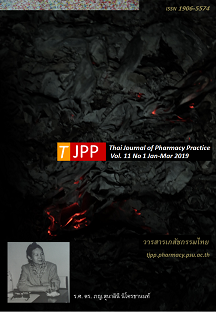ผลประโยชน์ด้านการเงินที่เกิดกับโรงพยาบาลจากการใช้ Vendor Management Inventory ของฝ่ายเภสัชกรรมโรงพยาบาล
Main Article Content
บทคัดย่อ
วัตถุประสงค์: เพื่อประเมินผลของการจัดการคลังยาแบบ Vendor Management Inventory (VMI) ระหว่างคลังยาและห้องจ่ายยาในประเด็นมูลค่ายาคงคลัง ระดับการให้บริการ และจำนวนวันที่ยาคงอยู่ในคลัง วิธีการ: การศึกษาแบ่งเป็น 3 ขั้นตอน คือ 1) การวิเคราะห์กิจกรรมของระบบการจัดการคลังยาแบบเดิม 2) การออกแบบกระบวนการ VMI ภายในองค์กรระหว่างคลังยาและห้องจ่ายยาผู้ป่วยนอก 3) การประเมินผล VMI แบบภายใน การศึกษาดำเนินการระหว่าง ตุลาคม 2557 ถึงพฤษภาคม 2558 ณ ศูนย์การแพทย์สมเด็จพระเทพรัตน์ราชสุดา โรงพยาบาลรามาธิบดี การศึกษาเลือกยาต้นแบบ 30 รายการเป็นตัวแทนยา 3 กลุ่ม กลุ่มละ 10 ตัว ได้แก่ 1) ยากลุ่ม A (ตามการจัดกลุ่มยาในวิธีการ ABC analysis) 2) ยากลุ่มที่มักขาดคลัง และ 3) ยา กลุ่มที่มีการสั่งจ่ายบ่อย ผลการศึกษา: รูปแบบการใช้ยาแบ่งเป็น 3 รูปแบบได้แก่ 1) แบบสม่ำเสมอเป็นรูปแบบการใช้ที่สม่ำเสมอซ้ำกันในทุกสัปดาห์ (7 รายการยา) 2) แบบไม่สม่ำเสมอเป็นกลุ่มยาที่มีการใช้ไม่สม่ำเสมอในทุกสัปดาห์ (มี 18 รายการ) และ 3) แบบที่ขึ้นกับผู้ป่วย (5 รายการ) รูปแบบการใช้ยาขึ้นกับการมาพบแพทย์ของผู้ป่วย และต้องมีจัดการคลังยาแบบจำเพาะแต่ละรายการยา การจัดการคลังยาแบบ VMI ที่ห้องจ่ายยาชั้น 1 ศูนย์การแพทย์สมเด็จพระเทพรัตน์ฯ ทำให้มูลค่ายาคงคลังมีค่าลดลง โดยในกลุ่มที่มีรูปแบบการใช้ยาแบบสม่ำเสมอและไม่สม่ำเสมอลดลงร้อยละ 30.98 และ 25.73 ตามลำดับ จำนวนวันเฉลี่ยที่ยาคงอยู่ในคลังลดลงจาก 10 วัน เป็น 6 และ 8 วันในกลุ่มยาที่มีรูปแบบการใช้แบบสม่ำเสมอและไม่สม่ำเสมอ ตามลำดับ ส่วนระดับการให้บริการอยู่ที่เกือบร้อยละ 100 ไม่แตกต่างกับระดับก่อนใช้ VMI อย่างไรก็ตาม ผลของ VMI ต่อการลดมูลค่ายาและจำนวนวันที่มียาคงอยู่ แตกต่างกันระหว่างกลุ่มยาที่มีรูปแบบการใช้แตกต่างกัน เภสัชกรผู้รับผิดชอบควรติดตามยากลุ่มที่มีการใช้แบบไม่สม่ำเสมออย่างใกล้ชิดเพื่อป้องกันยาขาดคลัง สรุป: การใช้ระบบ VMI ส่งผลให้มูลค่ายาคงคลังลดลงอย่างมากและยังมีประโยชน์ในด้านอื่น VMI ช่วยลดขั้นตอนการทำงาน ทำให้เภสัชกรสามารถให้เวลากับการทำงานที่เกี่ยวข้องกับผู้ป่วยมากขึ้น ทั้งยังทำให้เพิ่มเวลาให้แก่คลังยาในการวางแผนจัดการส่งยามายังห้องจ่ายยาได้ดีขึ้น
Article Details
ผลการวิจัยและความคิดเห็นที่ปรากฏในบทความถือเป็นความคิดเห็นและอยู่ในความรับผิดชอบของผู้นิพนธ์ มิใช่ความเห็นหรือความรับผิดชอบของกองบรรณาธิการ หรือคณะเภสัชศาสตร์ มหาวิทยาลัยสงขลานครินทร์ ทั้งนี้ไม่รวมความผิดพลาดอันเกิดจากการพิมพ์ บทความที่ได้รับการเผยแพร่โดยวารสารเภสัชกรรมไทยถือเป็นสิทธิ์ของวารสารฯ
เอกสารอ้างอิง
2. Uthayakumar R, Priyan S. Pharmaceutical supply chain and inventory management strategies: Optimization for a pharmaceutical company and a hospital. Oper Res Health Care 2013;2:52-64.
3. Kritchanchai D, Suwandechochai R. Supply chain management in health sector in Thailand: a case study. International Journal of Services, Economics and Management 2010;2:211-24.
4. Kritchanchai D. A Framework for healthcare supply chain improvement in Thailand. Operations and Supply Chain Management 2012;5:103-13.
5. Turhan SN, Vayvay Ö. Modeling of VMI implementation via SOA in a healthcare supply chain. In: European and Mediterranean Conference on Information
Systems 2009; July 13-14 2009; Crowne Plaza Hotel. Izmir; 1-14.
6. Watson N, Serumage B, McCord J. Selecting and implementing vendor managed inventory systems for public health supply chains: A guide for public sector managers. VA: USAID | DELIVER PROJECT, Task Order 4; 2012.
7. Zammori F, Braglia M, Frosolini M. A standard agreement for vendor managed inventory. Strategic Outsourcing 2009; 2:165-86.
8. Tanskanen K, Holmström J, Elfving J, Talvitie U. Vendor-managed-inventory (VMI) in construction. International Journal of Productivity and Performance Management 2009; 58:29-40.
9. Matopoulos A, Michailidou L. Implementing collaborative practices in the healthcare supply chain: insights into hospital-vendor operations. International Journal of Logistics Systems and Management 2013;15: 288-303.
10. Turhan SN, Vayvay Ö. Healthcare supply chain information systems via service-oriented architect- ture. In: Gunasekaran A, Sandhu M, editors. Hand- book on business information system. World Scientific Publishing; 2010. 3-24.
11. Halldórsson Á, Stefánsson G, Ståhl Elvander M, Sarpola S, Mattsson SA. Framework for characterizing the design of VMI systems. International Journal of Physical Distribution & Logistics Management 2007;37:782-98.
12. Department of Primary Industries and Mines. Logistics performance assessment manual, logistics performance index. Bangkok: MDICP Holding; 2013.
13. Singh RK. Analyzing the factors for VMI implementation: A framework. Global Bus Rev 2013;14:169-86.
14. Awaya T, Ohtaki K-i, Yamada T, Yamamoto K, Miyoshi T, Itagaki Y-i, et al. Automation in drug inventory management saves personnel time and budget. Yakugaku Zasshi 2005;125: 427-32.
15. Battini D, Hassini E, Manthou V, Machado Guimarães C, Crespo de Carvalho J, Maia A. Vendor managed inventory (VMI): evidences from lean deployment in healthcare. Strategic Outsourcing 2013;6:8-24.
16. Callender C, Grasman SE. Improving the healthcare supply chain using vendor managed inventory techniques. In: 27th Annual National Conference of the American Society for Engineering Management 2006, Managing change: Managing people and technology in a rapidly changing world; October 25-28, 2006; Huntsville, Alabama, USA; 2006. p. 510-16.
17. Shi H. Research on supply management in hospital based on VMI. In: 17th International conference on industrial engineering and engineering management: October 29-31, 2010; Xiamen, China; 2010. p 1395-99.
18. Okrent MD, Vokurka RJ. Process mapping in successful ERP implementations. Industrial Management & Data Systems 2004;104: 637-43.


